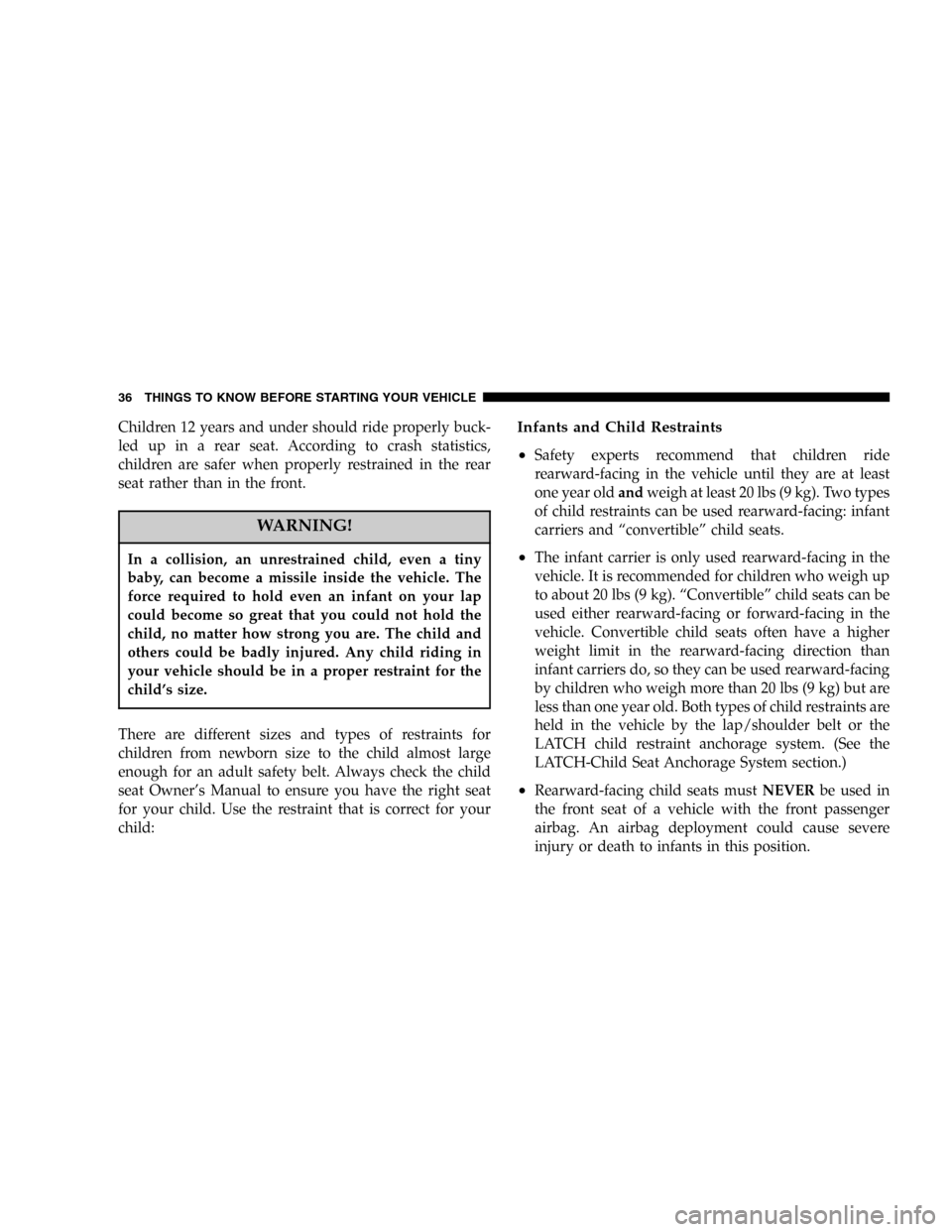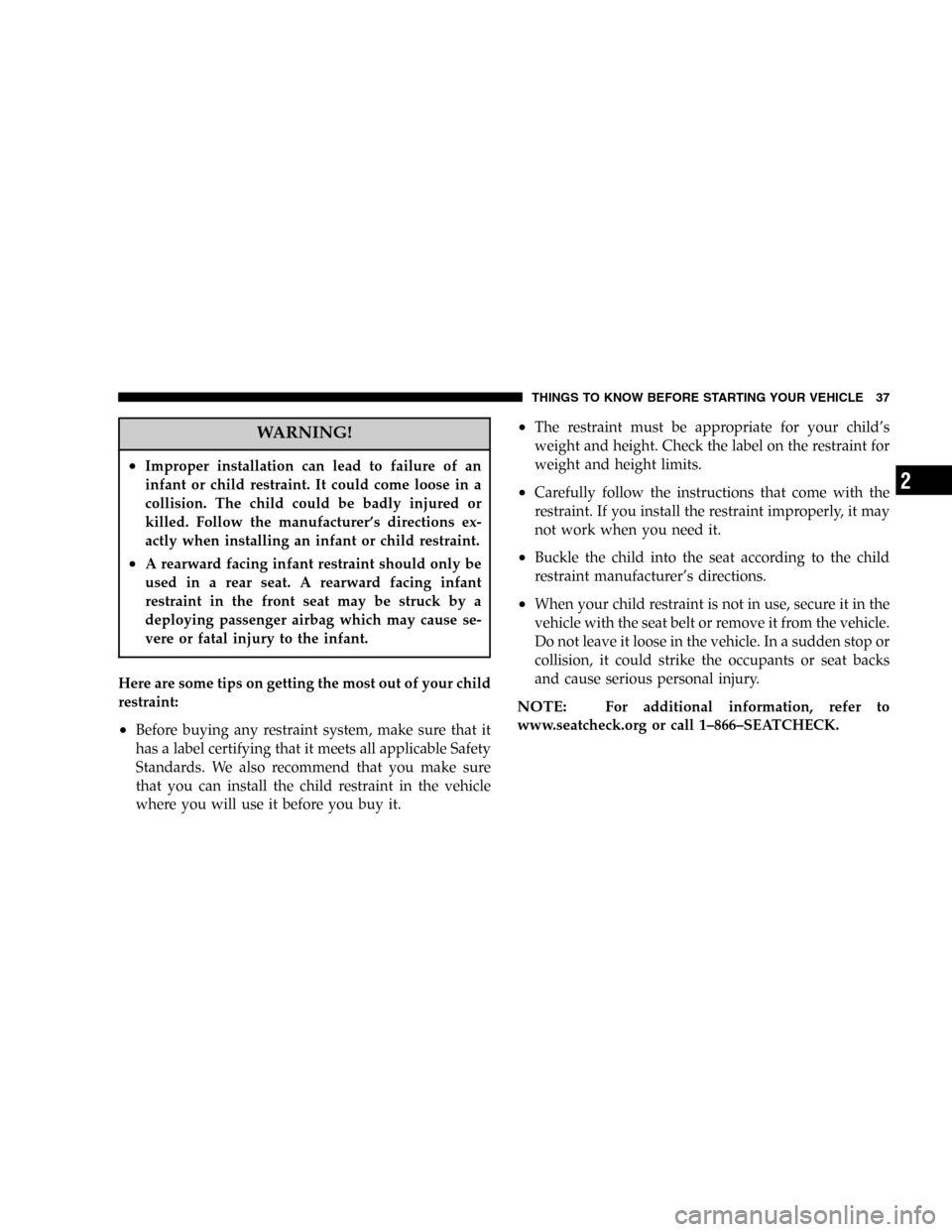2005 CHRYSLER SEBRING CONVERTIBLE weight
[x] Cancel search: weightPage 36 of 292

Children 12 years and under should ride properly buck-
led up in a rear seat. According to crash statistics,
children are safer when properly restrained in the rear
seat rather than in the front.
WARNING!
In a collision, an unrestrained child, even a tiny
baby, can become a missile inside the vehicle. The
force required to hold even an infant on your lap
could become so great that you could not hold the
child, no matter how strong you are. The child and
others could be badly injured. Any child riding in
your vehicle should be in a proper restraint for the
child’s size.
There are different sizes and types of restraints for
children from newborn size to the child almost large
enough for an adult safety belt. Always check the child
seat Owner’s Manual to ensure you have the right seat
for your child. Use the restraint that is correct for your
child:
Infants and Child Restraints
•
Safety experts recommend that children ride
rearward-facing in the vehicle until they are at least
one year oldandweigh at least 20 lbs (9 kg). Two types
of child restraints can be used rearward-facing: infant
carriers and“convertible”child seats.
•The infant carrier is only used rearward-facing in the
vehicle. It is recommended for children who weigh up
to about 20 lbs (9 kg).“Convertible”child seats can be
used either rearward-facing or forward-facing in the
vehicle. Convertible child seats often have a higher
weight limit in the rearward-facing direction than
infant carriers do, so they can be used rearward-facing
by children who weigh more than 20 lbs (9 kg) but are
less than one year old. Both types of child restraints are
held in the vehicle by the lap/shoulder belt or the
LATCH child restraint anchorage system. (See the
LATCH-Child Seat Anchorage System section.)
•Rearward-facing child seats mustNEVERbe used in
the front seat of a vehicle with the front passenger
airbag. An airbag deployment could cause severe
injury or death to infants in this position.
36 THINGS TO KNOW BEFORE STARTING YOUR VEHICLE
Page 37 of 292

WARNING!
•Improper installation can lead to failure of an
infant or child restraint. It could come loose in a
collision. The child could be badly injured or
killed. Follow the manufacturer’s directions ex-
actly when installing an infant or child restraint.
•A rearward facing infant restraint should only be
used in a rear seat. A rearward facing infant
restraint in the front seat may be struck by a
deploying passenger airbag which may cause se-
vere or fatal injury to the infant.
Here are some tips on getting the most out of your child
restraint:
•Before buying any restraint system, make sure that it
has a label certifying that it meets all applicable Safety
Standards. We also recommend that you make sure
that you can install the child restraint in the vehicle
where you will use it before you buy it.
•The restraint must be appropriate for your child’s
weight and height. Check the label on the restraint for
weight and height limits.
•Carefully follow the instructions that come with the
restraint. If you install the restraint improperly, it may
not work when you need it.
•Buckle the child into the seat according to the child
restraint manufacturer’s directions.
•When your child restraint is not in use, secure it in the
vehicle with the seat belt or remove it from the vehicle.
Do not leave it loose in the vehicle. In a sudden stop or
collision, it could strike the occupants or seat backs
and cause serious personal injury.
NOTE:For additional information, refer to
www.seatcheck.org or call 1–866–SEATCHECK.
THINGS TO KNOW BEFORE STARTING YOUR VEHICLE 37
2
Page 161 of 292

Tire and Loading Information Placard
This placard tells you important information about
the,
1) number of people that can be carried in the vehicle
2) the total weight your vehicle can carry
3) the tire size designed for your vehicle
4) the cold tire inflation pressures for the front, rear
and spare tires.
Loading
The vehicle maximum load on the tire must not exceed
the load carrying capacity of the tire on your vehicle. You
will not exceed the tire’s load carrying capacity if you
adhere to the loading conditions, tire size and cold tire
inflation pressures specified on the Tire and Loading
Information placard and the Vehicle Loading section of
this manual.
NOTE:Under a maximum loaded vehicle condition,
gross axle weight ratings (GAWR’s) for the front and rear
axles must not be exceeded. For further information on
GAWR’s, vehicle loading and trailer towing, see the
Vehicle Loading section of this manual.
To determine the maximum loading conditions of your
vehicle, locate the statement“The combined weight of
occupants and cargo should never exceed XXX kg or XXX
lbs.”on the Tire and Loading Information placard. The
combined weight of occupants, cargo/luggage and
trailer tongue weight (if applicable) should never exceed
the weight referenced here.
Tire and Loading Information
STARTING AND OPERATING 161
5
Page 162 of 292

Steps for Determining Correct Load Limit
1. Locate the statement“The combined weight of occu-
pants and cargo should never exceed XXX pounds”on
your vehicle’s placard.
2. Determine the combined weight of the driver and
passengers that will be riding in your vehicle.
3. Subtract the combined weight of the driver and pas-
sengers from XXX kilograms or XXX pounds.
4. The resulting figure equals the available amount of
cargo and luggage load capacity. For example, if“XXX”
amount equals 1400 lbs. and there will be five 150 lb.
passengers in your vehicle, the amount of available cargo
and luggage load capacity is 650 lb. (since 5 x 150 = 750,
and 1400–750 = 650 lb.)
5. Determine the combined weight of luggage and cargo
being loaded on the vehicle. That weight may not safely
exceed the available cargo and luggage load capacity
calculated in step 4.6. If your vehicle will be towing a trailer, load from your
trailer will be transferred to your vehicle. Consult this
manual to determine how this reduces the available
cargo and luggage load capacity of your vehicle.
NOTE:The following table shows examples on how to
calculate total load, cargo/luggage and towing capacities
of your vehicle with varying seating configurations and
number and size of occupants. This table is for illustra-
tion purposes only and may not be accurate for the
seating and load carry capacity of your vehicle.
NOTE:For the following example the combined weight
of occupants and cargo should never exceed 865 lbs. (392
Kg).
162 STARTING AND OPERATING
Page 179 of 292

VEHICLE LOADING
Vehicle Loading Capacities
Front Seat Occupants....................... 2
Rear Seat Occupants........................ 2
Luggage...................... 115lbs. (52 kg)
Rated Vehicle Capacity............ 715lbs. (324 kg)
TRAILER TOWING
In this section you will find safety tips and information
on limits to the type of towing you can reasonably do
with your vehicle. Before towing a trailer carefully re-
view this information to tow your load as efficiently and
safely as possible.
To maintain warranty coverage, follow the requirements
and recommendations in this manual concerning ve-
hicles used for trailer towing.
Perform maintenance services as prescribed in the main-
tenance schedules manual. When your vehicle is used for
trailer towing, never exceed the gross axle weight rating
(GAWR) by the addition of:
•The tongue weight of the trailer.
•The weight of any other type of cargo or equipment
put in or on your vehicle.
•Remember that everything put in or on the trailer adds
to the load on your vehicle.
Towing Requirements
•
The maximum trailer load is 1,000 lbs (450 kg).
•The maximum frontal area of the trailer cannot exceed
20 square feet (1.86 square meters).
•If using a manual transaxle vehicle for trailer towing,
all starts must be in FIRST gear to avoid excessive
clutch slippage.
•The trailer tongue load must be considered as part of
the combined weight of occupants and cargo, and
should never exceed the weight referenced on the Tire
and Loading Information placard. Refer to the Tire–
Safety Information Section in this manual.
•The“D”range can be selected when towing. However,
if frequent shifting occurs while in this range, the“3”
range must be selected.
STARTING AND OPERATING 179
5
Page 245 of 292

2. Disconnect the wiring connector as shown and re-
move the plastic retainers. Remove the light housing
from the vehicle.
3. Turn the bulb socket counterclockwise to remove it
from the housing. Remove the bulb and reinstall the bulb
and socket assembly.
4. Reinstall the light housing and reconnect the wiring
connector. Push the trunk liner back into place.
License Plate Bulb Replacement
1. Locate both small slots on the outboard side of the
license lamp. Using a small screwdriver, remove the
entire housing.
2. Turn the bulb socket counterclockwise to remove it
from the housing. Pull the bulb out of the socket. Replace
the bulb and snap it back into place on the housing of the
chrome appliqué.
Headlight Aiming
The headlights on your new vehicle were aimed at the
factory. The factory setting was made at a no load setting.
A great increase in weight will change the aiming and it
may be necessary to readjust the headlights if carrying an
excessive amount of weight in the trunk, rear seats or
pulling a trailer. To readjust the headlights first mark the
position of the headlights on a wall prior to loading the
vehicle. Load the vehicle and then readjust the headlights
to the original position. If any further adjustments are
necessary contact your manufacturer’s dealer. A detailed
service procedure is contained in the manufacturer’s
Service Manual. Information on purchasing a Service
Manual can be found at the back of this Owner’s Manual.
MAINTAINING YOUR VEHICLE 245
7
Page 279 of 292

Auxiliary Power Outlet................... 82
Ball Joints............................ 216
Battery............................... 213
Emergency Starting.................... 193
Gas Caution......................195,214
Heater............................. 146
Jump Starting........................ 193
Keyless Transmitter Replacement.......... 19
Location.........................193,213
Belts, Drive........................... 210
Belts, Engine.......................... 212
Body Mechanism Lubrication.............. 216
Boot, Convertible Top.................... 52
B-Pillar Location....................... 160
Brake, Parking......................... 151
Brake System.......................153,224
Anti-Lock........................... 153
Fluid Check......................... 226
Hoses.............................. 225
Master Cylinder...................... 226
Warning Light........................ 95
Brake/Transmission Interlock...........147,149Break-In Recommendations, New Vehicle...... 43
Bulb Replacement...................... 240
Bulbs, Light........................... 239
Capacities, Antifreeze (Engine Coolant)...... 246
Capacities, Fluid....................... 246
Capacity, Cargo Weight.................. 179
Caps, Filler
Fuel............................... 177
Oil (Engine)......................... 209
Radiator (Coolant Pressure).............. 222
Car Washes........................... 230
Carbon Monoxide Warning............... 177
Carpeting............................. 232
Cassette Tape and Player Maintenance....... 126
Cassette Tape Player...............102,110,113
Catalytic Converter..................... 211
CD Changer..................109,114,119,121
CD Player....................107,115,117,125
Center High Mounted Stop Light........... 244
Central Locking......................... 14
Chains, Tire........................... 171
Changing A Flat Tire.................... 188
INDEX 279
10
Page 290 of 292

Top Cover............................. 52
Towing.........................179,197,198
Disabled Vehicle...................... 197
Trailering........................... 179
Traction Control....................73,91,155
Traction Control Switch................73,155
Trailer Towing......................... 179
Minimum Requirements................ 179
Trailer and Tongue Weight.............. 179
Warnings........................... 179
Transaxle............................. 227
Additives........................... 229
Automatic.....................147,149,227
Autostick........................... 173
Filter.............................. 229
Overdrive........................... 150
Selection of Lubricant.................. 227
Transmission
Range Indicator....................... 93
Transmission....................See Transaxle
Transmitter Battery Service................ 19
Transmitter, Garage Door Opener............ 77
Transmitter, Remote Keyless Entry........... 16Transporting Pets........................ 43
Tread Wear Indicators................... 169
Trip Computer.......................... 97
Trip Odometer.......................... 93
Trip Odometer Reset Button................ 93
Trunk Release, Emergency...............21,22
Trunk Release Remote Control.............. 21
Turn Signals.........................70,92
Underhood Fuses....................... 236
Uniform Tire Quality Grades.............. 274
Universal Transmitter.................... 77
Unleaded Gasoline...................... 174
Vacuum/Vapor Harnesses................ 224
Vanity Mirrors.......................... 61
Vehicle Identification Number............... 6
Vehicle Loading........................ 161
Vehicle Modifications/Alterations............ 6
Vehicle Storage......................... 239
Vehicle Theft Alarm...................... 19
Vinyl Trim............................ 232
Viscosity, Engine Oil..................... 246
290 INDEX